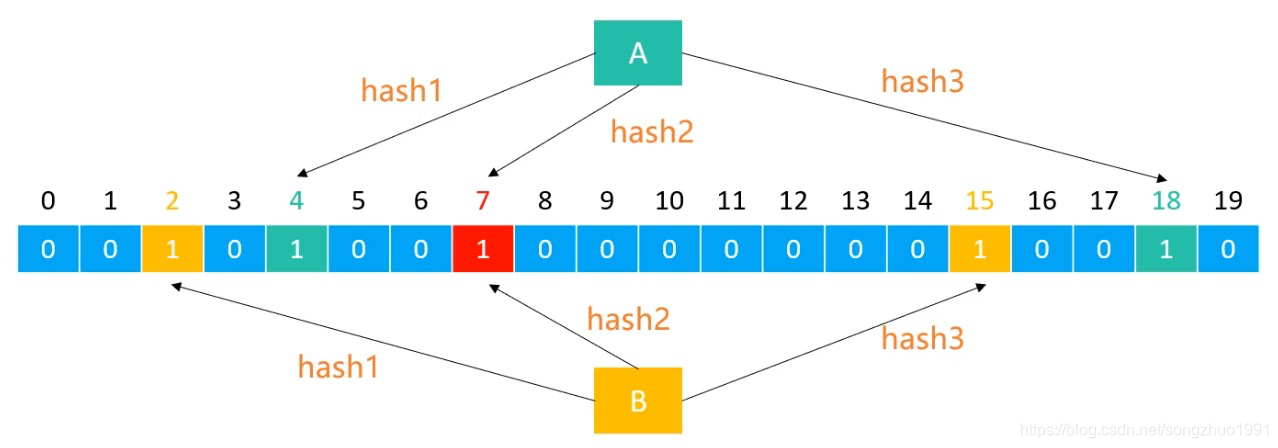本文主要是介绍数据结构 - 布隆过滤器(Bloom Filter),希望对大家解决编程问题提供一定的参考价值,需要的开发者们随着小编来一起学习吧!
思考
- 如果要经常判断1个元素是否存在,你会怎么做?
很容易想到使用哈希表(HashSet、HashMap),将元素作为key去查找
时间复杂度:O(1),但是空间利用率不高,需要占用比较多的内存资源 - 如果需要编写一个网络爬虫去爬10亿个网站数据,为了避免爬到重复的网站,如何判断某个网站是否爬过?
很显然,HashSet、HashMap并不是非常好的选择 - 是否存在时间复杂度低、占用内存较少的方案?
- 布隆过滤器(Boolm Filter)
- 1970年由布隆提出
它是一个空间效率高的概率型数据结构,可以用来告诉你:一个元素一定不存在或者可能存在 - 优缺点
优点:空间效率和查询时间都远远超过一般的算法
缺点:有一定的误判率、删除困难
它实质上是一个很长的二进制向量和一系列随机映射函数(Hash函数) - 常见应用
- 网页黑名单系统、垃圾邮件过滤系统、爬虫的网站判重系统、解决缓存穿透问题
原理
- 假设布隆过滤器由20位二进制、3个哈希函数组成,每个元素经过哈希函数处理都能生成一个索引位置
- 添加元素:将每一个哈希函数生成的索引位置都设为1
- 查询元素是否存在
如果一个哈希函数生成的索引位置不为1,就代表不存在(100%准确)
如果一个哈希函数生成的索引位置都为1,就代表存在(存在一定的误判率)

- 添加、查询的时间复杂度都是:O(k),k是哈希函数的个数。
- 空间复杂度是:O(m),m是二进制位的个数
误判率
- 误判率p受3个因素影响:二进制位的个数m、哈希函数的个数k、数据规模n

- 已知误判率p、数据规模n,求二进制位的个数m、哈希函数的个数
 )
)
实现
public class BoloomFilter<T> {// 二进制向量的长度(一共有多少个二进制位)private int bitSize;// 二进制向量private long[] bits;// 哈希函数的个数private int hashSize;/ *** @param n 数据规模* @param p 误判率,取值范围(0, 1)* /public BloomFilter(int n, double p) {if (n <= 0 || p <= 0 || p >= 1) {throw new IllegalArgumentException("wrong n or p");}double ln2 = Math.log(2);// 求出二进制向量的长度bitSize = (int)(-(n * Math.log(p)) / (ln2 * ln2));// 哈希个数hashSize = (int)(bitSize * ln2 / n);// bits数组的长度bits = new long[(bitSize + Long.SIZE - 1) / long.SIZE// 每一页显示100条数据, pageSize// 一共有999999条数据, n// 请问有多少页 pageCount = (n + pageSize - 1) / pageSize}// 添加元素1// return 返回true 代表改变public boolean put(T value) {nullCheck(value);// 利用value生成2个整数int hash1 = value.hashCode();int hash2 = has1 >>> 16;boolean result = false;for (int i = 0; i <= hashSize; i++) {int combinedHash = hash1 + (i * hash2);if (combinedHash < 0) {combinedHash = ~combinedHash;}// 生成一个二进位的索引int index = combinedHash % bitSize;// 设置index位置的二进位为1if (set(index)) result = true;// 101010101010010101// | 000000000000000100 1 << index// 101010111010010101}return result;}// 判断一个元素是否存在// return true 代表存在public boolean contains(T value) {nullCheck(value);// 利用value生成2个整数int hash1 = value.hashCode();int hash2 = has1 >>> 16;for (int i = 0; i <= hashSize; i++) {int combinedHash = hash1 + (i * hash2);if (combinedHash < 0) {combinedHash = ~combinedHash;}// 生成一个二进位的索引int index = combinedHash % bitSize;// 查询index位置的二进位是否为0if (!get(index)) return false;}return true;}// 设置index位置的二进位为1private boolean set(int index) {long value = bits[index / Long.SIZE];int bitValue = 1 << (index % Long.SIZE);bits[index / long.SIZE] = value | bitValue;return (value & bitValue) == 0;}// 查看index位置的二进位的值private boolean get(int index) {long value = bits[index / Long.SIZE];return (value & (1 << (index % Long.SIEZ))) != 0; }private void nullCheck(T value) {if (value == null) {throw new IllegalArgumentException("Value must not be null.");}}
}
测试
public class Main {public static void main(String[] args) {// TODO Auto-generated method stub
// BloomFilter<Integer> bf = new BloomFilter<>(1_00_0000, 0.01);
// for (int i = 1; i <= 1_00_0000; i++) {
// bf.put(i);
// }
//
// int count = 0;
// for (int i = 1_00_0001; i <= 2_00_0000; i++) {
// if (bf.contains(i)) {
// count++;
// }
// }
// System.out.println(count);// 数组String[] urls = {};BloomFilter<String> bf = new BloomFilter<String>(10_0000_0000, 0.01);/*for (String url : urls) {if (bf.contains(url)) continue;// 爬这个url// ......// 放进BloomFilter中bf.put(url);}*/for (String url : urls) {if (bf.put(url) == false) continue;// 爬这个url// ......}}}
- Guava:Google Core Libraries For Java
这篇关于数据结构 - 布隆过滤器(Bloom Filter)的文章就介绍到这儿,希望我们推荐的文章对编程师们有所帮助!






